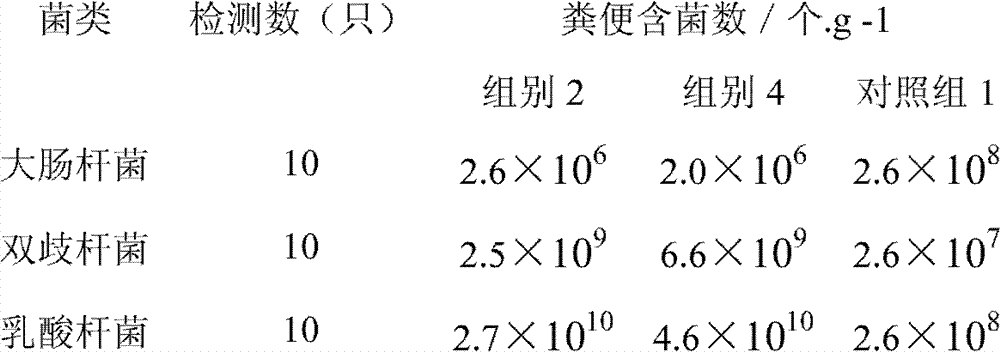Micro-ecological synbiotic feed addictive, preparation method and application thereof
A feed additive and micro-ecological technology, applied in the field of micro-ecological feed additives, can solve the problems of Lactobacillus being heat-resistant and Bacillus subtilis not producing lactic acid, etc., so as to reduce feeding costs, benefit human health and environmental protection, and improve production efficiency effect
- Summary
- Abstract
- Description
- Claims
- Application Information
AI Technical Summary
Problems solved by technology
Method used
Image
Examples
Embodiment 1
[0031] Example 1 Preparation of Microecological Synbiotic Feed Additive
[0032] 1. Weigh the oligosaccharides as fructooligosaccharides, xylo-oligosaccharides, isomalto-oligosaccharides and soybean oligosaccharides each 10Kg for use;
[0033] 2. Preparation of Bacillus lactis preparation:
[0034] The strain is freeze-dried lactic acid bacillus; the weight of the lactic acid bacillus medium is composed of the following components: 0.5 part peptone, 0.3 part beef extract, 0.1 part yeast extract, 0.5 sodium chloride Parts, MnSO 4 Copies. H 2 O 0.005 parts, CaCl 2 0.00756 copies, MgSO 4 .7H 2 O 0.05 parts, 99 parts ultrapure water, pH 6.8, autoclaved at 115°C for 30 min;
[0035] ①Expand the seed bacteria, inoculate the bacteria on the slope (such as an inoculation loop) into the test tube containing the lactobacillus culture medium, and incubate at 37°C for 24 hours to obtain the first-level seed bacteria, take it out of the refrigerator and save it for later use;
[0036] ②Preparation...
Embodiment 2
[0050] Example 2 Feeding effect of goslings
[0051] A total of 210 1-day-old Rhine geese with an average weight of 87.35±2.21g were selected and randomly divided into 5 treatment groups according to gender and weight. Each treatment had 3 replicates, and each replicate had 14 young geese, half male and half female. The experiment started at 1 day and ended at 14 days. The diet combination of each group is shown in Table 1.
[0052] Table 1 Experimental grouping and diet combination
[0053]
[0054] The base material is conventional gosling feed sold in the market; the above percentages are weight percentages
[0055] Table 2 Effects of different combinations and dosages on the performance of goslings (g)
[0056]
[0057] Note: The data adopts the mean ± standard deviation; the same row of figures * with ** Indicates a significant level difference between 0.05 and 0.01.
[0058] It can be seen from Table 2 that the daily weight gain, feed intake and feed-to-meat ratio test 4 groups a...
Embodiment 3
[0062] Example 3 Feeding effect of chicks
[0063] In the experiment, 270 1-day-old laying chicks were randomly divided into 6 treatment groups according to sex and body weight. Each group had 3 replicates, each with 15 chicks, and the experiment period was 5 weeks. The diet combination of each group is shown in Table 4.
[0064] Table 4 Experimental grouping and diet combination
[0065]
[0066] The above percentages are percentages by weight
[0067] Table 5 The effect of different combinations and dosages on the performance of chicks (g)
[0068]
[0069] Note: The data adopts the mean ± standard deviation; the same row of figures * with ** Indicates a significant level difference between 0.05 and 0.01.
[0070] It can be seen from Table 5 that in the 1-35 days of age, the daily gain, feed intake and feed-to-meat ratio test of the 8 groups were significantly better than the control group and other test groups ( * p** P<0.01)
[0071] Table 6 Effects of probiotics and synbiotics on Es...
PUM
 Login to View More
Login to View More Abstract
Description
Claims
Application Information
 Login to View More
Login to View More - R&D
- Intellectual Property
- Life Sciences
- Materials
- Tech Scout
- Unparalleled Data Quality
- Higher Quality Content
- 60% Fewer Hallucinations
Browse by: Latest US Patents, China's latest patents, Technical Efficacy Thesaurus, Application Domain, Technology Topic, Popular Technical Reports.
© 2025 PatSnap. All rights reserved.Legal|Privacy policy|Modern Slavery Act Transparency Statement|Sitemap|About US| Contact US: help@patsnap.com



